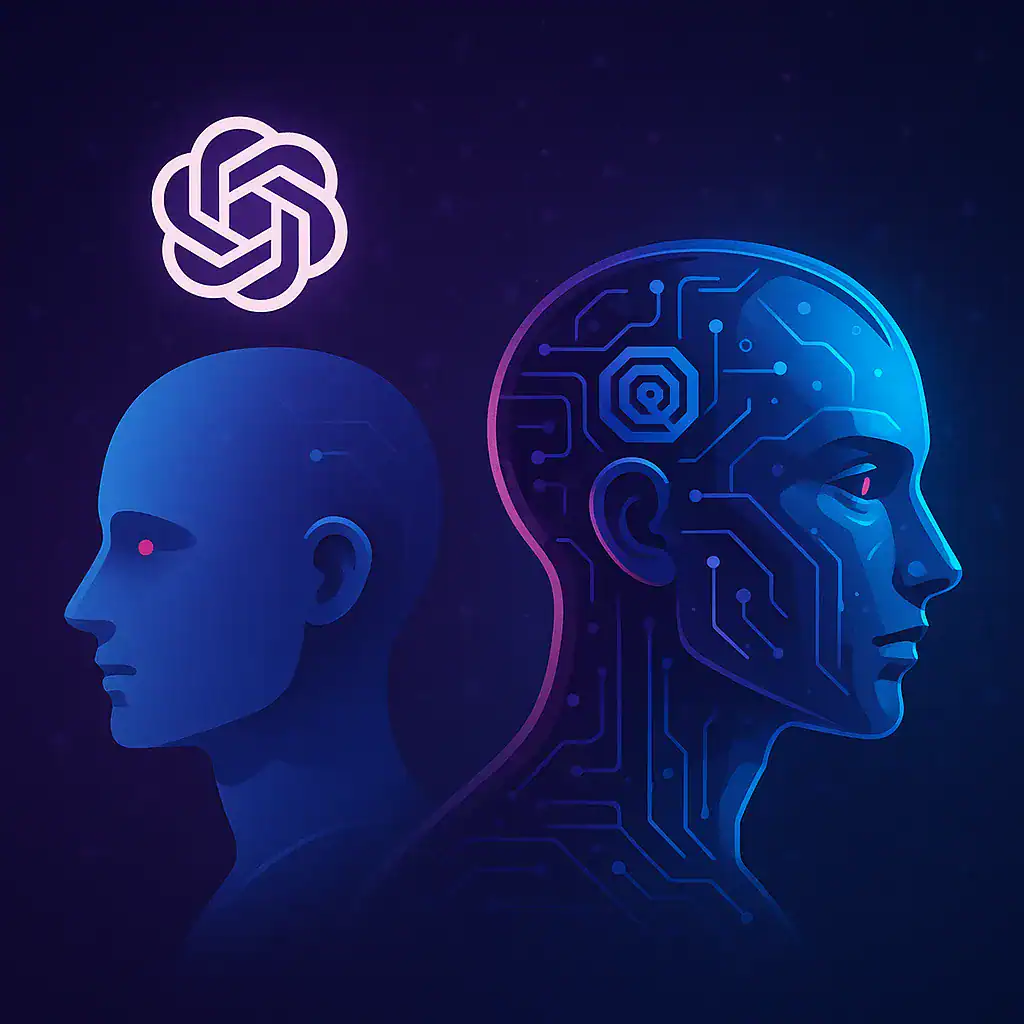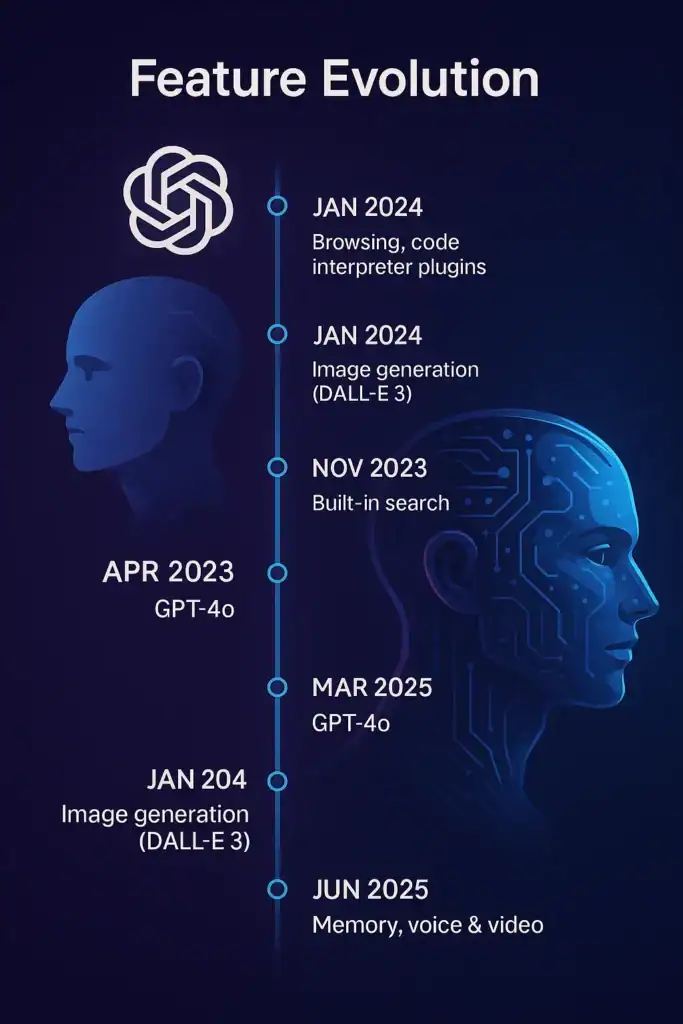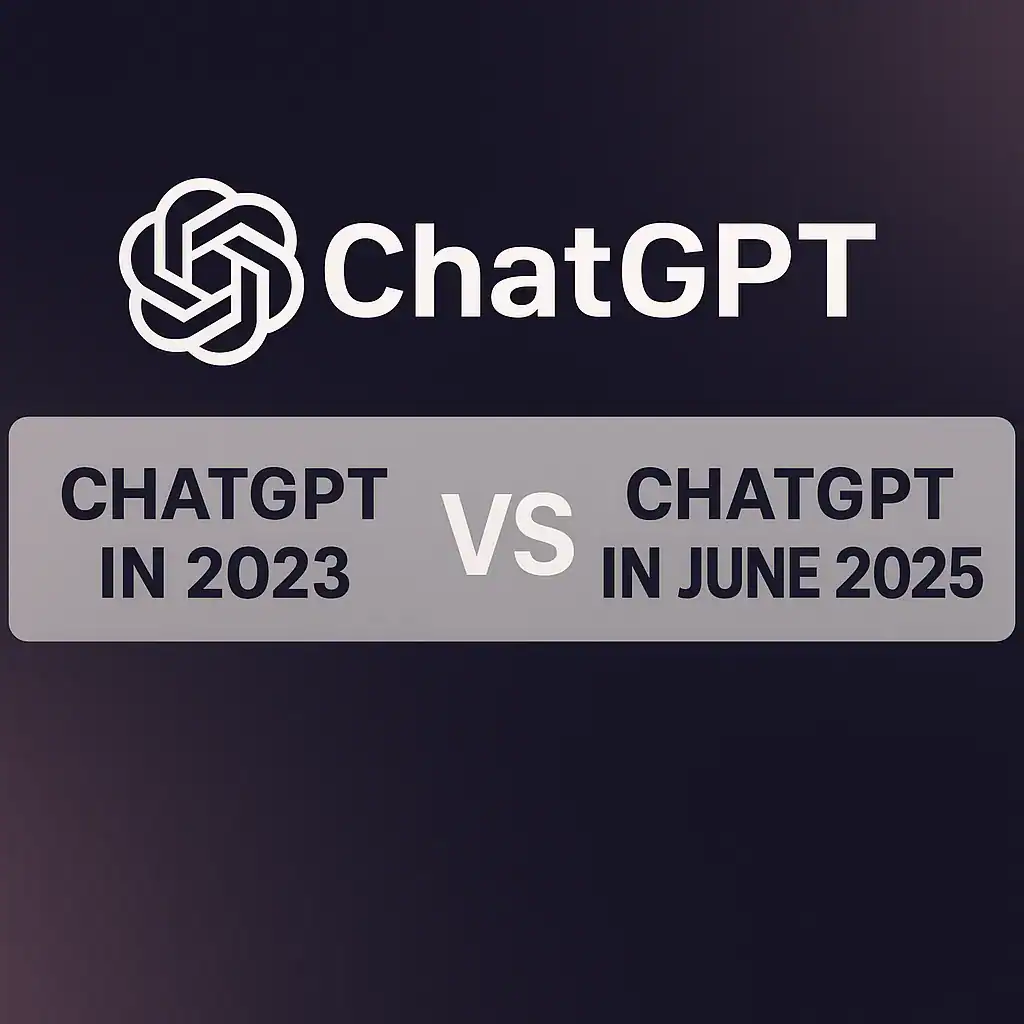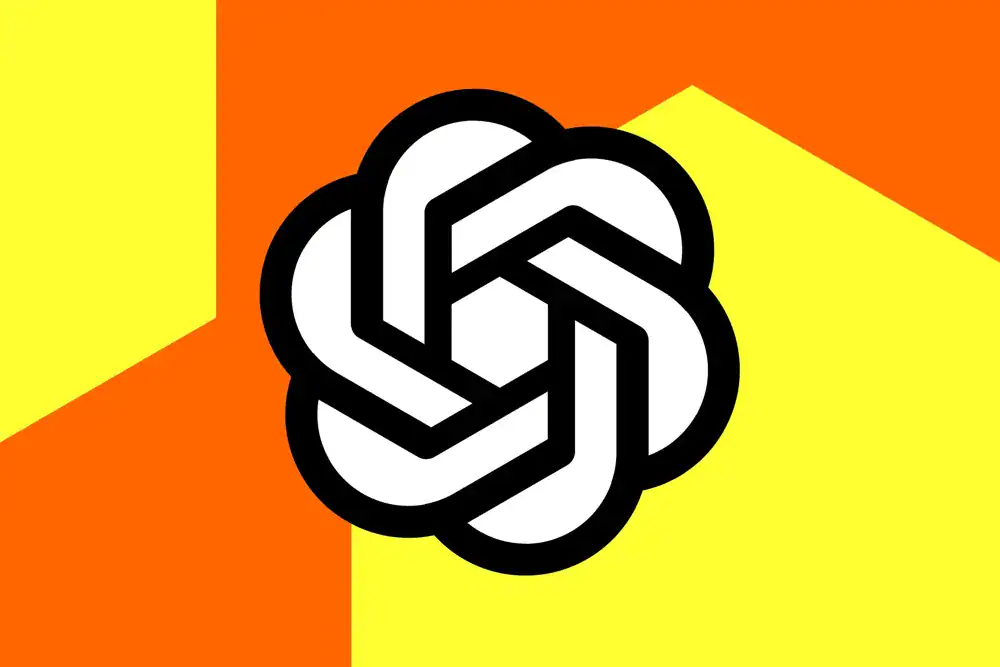ChatGPT evolution from 2023 to 2025 marks one of the most significant leaps in AI assistant technology. In 2023, it started as a text-only chatbot based on the GPT-3.5/4 models, with basic conversation and coding assistance. By June 2025, it has transformed into a multimodal “AI super-assistant” – capable of voice interaction, image generation, web browsing, and even autonomous actions. Below is a detailed comparison of ChatGPT’s features and capabilities in 2023 versus June 2025, organized by key areas of improvement.
Table of Contents
🚀 ChatGPT in 2023
- Model & Platform: OpenAI launched ChatGPT as a free research preview in late 2022, powered by the GPT‑3.5 model. In March 2023, ChatGPT was upgraded to use the more powerful GPT‑4 model (for those with a subscription), offering improved reasoning and a larger context window (up to ~32K tokens). OpenAI also introduced a $20/month ChatGPT Plus subscription in early 2023, which gave users priority access, faster responses, and early access to new features.
- Core Capabilities: In 2023, ChatGPT was primarily a text-based AI assistant. It could understand natural language prompts and generate responses for a wide range of tasks: answering questions, drafting articles/essays, writing code snippets, brainstorming ideas, etc. It excelled at language understanding and generation, but its outputs were limited to text (no speaking or image outputs). It also had a tendency to occasionally produce factually incorrect information (so-called AI “hallucinations”), as it relied solely on its training data and had no direct access to real-time information.
- Plugins and Tools: A major leap in 2023 was the introduction of ChatGPT Plugins (in alpha around March 2023) for Plus users. Plugins enabled ChatGPT to interact with external services and data. Early plugins included a web browsing tool (allowing the model to fetch information from the internet), a Code Interpreter (to execute Python code and work with file uploads), and third-party integrations like Expedia (travel planning), Wolfram|Alpha (advanced math and data queries), OpenTable (restaurant reservations), Zapier (to perform actions in other apps), and more. These plugins significantly extended ChatGPT’s functionality beyond what was possible with its internal training data alone. However, in 2023 these tools were opt-in and somewhat experimental – users had to explicitly enable the browsing beta or other plugins, and the browsing had limitations (it was even disabled for a time due to content concerns).
- GPT Store (Custom GPTs): Toward the end of 2023, OpenAI revealed a new concept: custom GPTs that users could create and share. At the OpenAI DevDay in November 2023, they announced the ability for anyone to build tailored versions of ChatGPT (with custom instructions, knowledge, and skill combinations). OpenAI launched a GPT Store in early 2024 to host these user-created chatbots. (Think of it as an app store, but for AI personas.) In late 2023 this was just starting – by Jan 2024 users could create personal GPTs and share them, although this wasn’t a core feature of ChatGPT in 2023 itself (it became more prominent in 2024).
- Multimodality & Voice: For most of 2023, ChatGPT was limited to text input and output. It did not have native image understanding or generation, nor any built-in voice features. The model couldn’t see or speak. The only way to get images out of ChatGPT was via plugin: in autumn 2023, OpenAI integrated DALL·E 3 image generation into ChatGPT for Plus users (via the GPT-4 Turbo model). This allowed users to ask ChatGPT (GPT-4 Turbo) to create images, but it was essentially using a separate DALL·E 3 system behind the scenes. Likewise, around the same time (Sept 2023), OpenAI introduced a voice input/output option in the ChatGPT mobile apps, letting users talk to ChatGPT and hear it respond with a synthetic voice. However, this early voice feature was relatively basic and limited to certain platforms. In summary, 2023’s ChatGPT was not truly multimodal – it was mainly a text chatbot, with rudimentary add-ons for images and voice by late 2023.
- Search Capability: ChatGPT (2023) did not have built-in up-to-date web access by default. Its knowledge cutoff was 2021, so it couldn’t know anything about events after that, unless you used a plugin. In mid-2023, OpenAI experimented with a Beta Browse with Bing feature for Plus users, but it wasn’t reliable and was temporarily disabled. Essentially, the average user in 2023 had no real-time search. You asked questions and got answers purely from ChatGPT’s training data or reasoning. The idea of integrated search within ChatGPT only came later (late 2024). By contrast, a user in 2023 would have to use the browser plugin or copy-paste info themselves for any current data. (This limitation started changing in Oct 2024 with the introduction of ChatGPT’s own search tool, as discussed below.)
- Memory Limitations: In 2023, ChatGPT’s “memory” was session-limited. It could remember what was said earlier in the same conversation (up to a certain token limit), which allowed for context and follow-up questions. However, once a chat was closed or a new session started, ChatGPT had no recollection of past interactions. Every new chat was like talking to a fresh instance of the AI. There was no long-term profile or personalization stored of the user. Users could save conversation transcripts on their account (as a history), but the AI itself wouldn’t refer to those past chats unless the user manually copy-pasted info. In short, there was no persistent memory of user preferences or previous conversations beyond each individual chat session.
🧠 ChatGPT Evolution in June 2025
By mid-2025, ChatGPT evolved into a far more powerful and feature-rich platform. Many of the limitations of the 2023 version have been addressed, and numerous new capabilities have been added:

- Diverse Model Lineup: Instead of just GPT-3.5 or GPT-4, ChatGPT now offers multiple models to choose from, each suited to different tasks. In May 2024 OpenAI launched GPT-4o (“omni”), a flagship multimodal model that can process text, images, and audio. GPT-4o became the default free model (replacing GPT-3.5) and gave even non-paying users access to advanced reasoning and multimodal input. OpenAI didn’t stop there – they released a series of “o” models (named o1, o3, etc.) over late 2024/early 2025. There was also GPT-4o mini, a lighter version of 4o that rolled out in July 2024 to handle everyday chats more efficiently. By June 2025, the lineup includes o3-pro, an enhanced version of the o-series model available to Pro and Team subscribers that delivers the best reasoning and reliability for complex queries. In summary, ChatGPT 2025 gives users a range of model options – from faster lightweight models to very powerful ones – whereas in 2023 users essentially had one main model (with an option to switch to GPT-4 if on Plus).
- GPT-4.5 (“Orion”): One of the biggest model upgrades was GPT-4.5, codenamed “Orion,” released in Feb 2025. GPT-4.5 is described as OpenAI’s largest and most advanced model to date. It was initially only available to those on the highest-tier $200/month ChatGPT Pro plan. This model is a step above GPT-4 in many ways: it has even more knowledge and supposedly far less tendency to hallucinate incorrect facts. GPT-4.5 also introduced or enhanced a slew of features in ChatGPT: it supports the new web search function natively, the Canvas feature (a visual whiteboard where you and the AI can interact with images/diagrams), and it allows file and image uploads directly in the chat. Essentially, GPT-4.5 turned ChatGPT into a more complete assistant that can utilize various modalities in one place. (Notably, GPT-4.5 at launch did not work with the voice mode yet, as voice was handled by GPT-4o’s technology – but by mid-2025, integration between these capabilities has improved.) GPT-4.5 is also huge and resource-intensive – it’s not a model that runs quickly, hence reserved for paid users and special cases.
- Native Multimodal Abilities: Unlike the 2023 version, ChatGPT in 2025 is fully multimodal by default. The introduction of GPT-4o in 2024 meant that free users could input images (e.g. upload a picture and ask ChatGPT about it) and get text descriptions or analysis back. As of March 2025, ChatGPT gained the ability to generate images natively using a built-in image generation model (referred to as GPT-Image-1). This replaced the need to call an external DALL·E plugin – now the AI itself can create and edit images in response to prompts. ChatGPT can also handle audio: you can speak to it (speech-to-text) and it can respond in audio (text-to-speech), and it can even analyze audio clips you provide in some cases. There’s mention of video support as well (likely the ability to analyze video content or generate simple videos), though text, images, and audio are the primary modes. All these modes are integrated, so a single conversation could involve text, voice, and images together. Advanced Voice Mode in particular received a big upgrade in June 2025 – the AI’s spoken voice became much more natural and expressive, with better intonation, the ability to convey emotions like empathy or sarcasm, and even do on-the-fly translations. For example, ChatGPT can now serve as a real-time translator between languages in voice conversations. This means by 2025, interacting with ChatGPT can feel much more like talking to a human-like assistant that talks back with personality, versus the purely text interactions of 2023.
- Long-Term Memory: Perhaps one of the most user-visible changes is that ChatGPT 2025 has a concept of long-term memory and personalization. OpenAI rolled out an update in spring 2025 that allows ChatGPT to remember past conversations and user instructions even across sessions. For example, if in a previous chat you told ChatGPT your favorite color is blue or you prefer answers in a certain style, the system can recall that info later without you repeating it. Initially, this feature (often just called “Memory”) was available to Plus/Pro users within the “Projects” feature (more on Projects below), but as of June 2025 a lighter version of it was enabled for free users as well. Free users get a short-term memory across recent chats (to maintain continuity), while paid users’ AI can remember even older conversations in detail. This is a huge improvement from 2023, where the AI forgot everything once a chat ended. Now ChatGPT feels more persistent – you don’t have to re-explain common info each time. (Of course, privacy controls exist and users can turn this off if they don’t want the AI to retain data.) In summary, by 2025 ChatGPT can learn about you over time (within limits) and use that to tailor its responses, which makes it much more personalized and context-aware than the stateless 2023 version.
- Projects Workspace: In 2023, OpenAI had a very simple “chat history” sidebar where you could organize conversations into folders or rename them, but it wasn’t very dynamic. By 2025, this evolved into ChatGPT Projects, a feature that turns ChatGPT into a productivity and research workspace. A Project is like a workspace with multiple related chats and files on a topic. The big change in June 2025 was that Projects now preserve context across all chats in the project. For example, if you have a Project called “Vacation Planning” with separate chats for “flights research” and “hotel options,” ChatGPT considers them in one context – it knows they’re related and can draw information from one when working on another. It also remembers your preferences (e.g. you said in one chat you have a budget constraint; in another chat in that project, it will remember that). Projects also allow you to upload files (PDFs, images, etc.) into the workspace and have the AI analyze them, and you can even use voice input within a project to discuss those files. Essentially, Projects turned ChatGPT into a kind of smart notebook or personal assistant that can manage collections of information over time. By making ChatGPT more organized and “aware” within a project, it became a much stronger tool for long-running tasks (research projects, work tasks, learning a topic over weeks, etc.). Note that as of June 2025, the fully upgraded Projects features (like cross-chat memory) are mainly for Plus/Pro users – but this is likely to trickle to free users later. This is a stark contrast to 2023’s basic interface; ChatGPT now can function as a multi-session personal research assistant.
- Autonomous Agents (Deep Research & Operator): ChatGPT’s functionality by 2025 isn’t limited to just back-and-forth chatting. OpenAI has integrated agent tools that let ChatGPT operate autonomously for certain tasks:
- Deep Research: Introduced in February 2025, Deep Research is an AI agent mode where you give ChatGPT a research task, and it will autonomously browse the web for 5–30 minutes and then produce a detailed, cited report on the topic. For instance, you could ask “Investigate the latest trends in renewable energy and give me a summary with sources.” ChatGPT (in Deep Research mode) will actually visit websites, read documents, and compile an answer with footnote citations linking to the sources it found. This was a big step toward making ChatGPT an automated research analyst rather than just a conversational partner. (Deep Research uses a specialized model, and it’s constrained to ensure it doesn’t do anything too crazy on the web – it’s designed to read info, not post or interact beyond basic browsing.)
- Operator: Launched in late Jan 2025, OpenAI Operator is another agent that allows ChatGPT to perform actions on the web on behalf of the user. Think of tasks like filling out forms, buying something online, scheduling an appointment, or navigating a website’s interface – Operator can do that. For example, you could instruct ChatGPT Operator to “Book me two tickets for the 7pm show at the local theater next Friday” and, if configured properly, it can go through the steps of finding the website, selecting seats, and proceeding to checkout (with user confirmation for payments). In essence, Operator is an attempt to let ChatGPT use a web browser like a human would, turning it into more of an actual virtual assistant that can act, not just converse. In June 2025, Operator is still in a limited preview (only available to Pro tier subscribers and only in certain regions) as OpenAI tests it out, due to the obvious safety and accuracy challenges. But it represents a big difference from 2023: ChatGPT is becoming capable of doing things online, not just telling you how to do them.
- “Tasks” Scheduling: Another new feature bridging ChatGPT towards a true assistant is called Tasks. Rolled out in beta around January 2025, Tasks let users schedule ChatGPT to perform certain actions or send certain info at a later time. Essentially, you can set a reminder or recurring task through ChatGPT. For example, you might say “Every Monday morning, give me a summary of the stock market news,” or “Remind me on Oct 1st to wish John a happy birthday.” ChatGPT will then automatically generate the output or reminder at that time. This directly competes with the likes of Siri, Alexa, or Google Assistant’s reminder features. ChatGPT can also suggest tasks proactively based on your conversations (e.g. if you discuss a concert, it might suggest “Do you want me to remind you when tickets go on sale?”). In June 2025, the Tasks feature is available to Plus, Teams, and Pro users in beta, and it shows how ChatGPT is moving beyond on-demand Q&A to more proactive assistance in a user’s life.
- Built-in Web Search: Perhaps one of the most anticipated changes since 2023 is that ChatGPT now has built-in web browsing/search for everyone. OpenAI launched ChatGPT Search in late October 2024, initially to Plus users, and then expanded it to all users by early 2025. This means ChatGPT is no longer stuck with outdated knowledge – it can retrieve real-time information from the internet. When you ask a question that requires current data or is about a niche topic, ChatGPT can automatically run a web search and incorporate the results into its answer, citing the sources (you’ll see footnote numbers you can click to verify the info). For example, you could ask, “What’s the weather in Paris today?” or “Who won the football game last night?” and ChatGPT will use the search tool to get live info and then respond. In 2023, ChatGPT would have simply said it cannot access current info – in 2025, it can. The integration of search effectively marries a traditional search engine’s capability with ChatGPT’s conversational format. It’s also worth noting that ChatGPT’s approach to search is conversational: it will often do multiple searches behind the scenes, refine queries, and then present a synthesized answer with references. This makes getting information more seamless for the user. In short, by 2025 ChatGPT serves not just as an AI chatbot, but also as a real-time knowledge engine, eliminating a huge limitation it had in 2023.
- Business & Enterprise Features: OpenAI has also tailored ChatGPT for professional and enterprise use by 2025. They introduced Business plans (ChatGPT Team and Enterprise) with enhanced data privacy and organizational features. In June 2025, OpenAI announced new updates to these plans, including Connectors that let ChatGPT interface with internal company tools and databases. For example, a company can connect ChatGPT to their knowledge base or HR system – employees could then ask ChatGPT questions about internal policies or have it pull data from a private database (with appropriate permissions). OpenAI also introduced a concept called Custom Connectors via MCP (Model Context Protocol), which allows developers to build bespoke integrations so ChatGPT can securely query any internal API. Another feature is ChatGPT Record Mode, essentially letting ChatGPT join meetings or calls (via integrations with conferencing platforms) to record and transcribe them, and even summarize action items afterwards. For instance, ChatGPT could sit in your Zoom meeting (as an attendee) and later provide a summary of the discussion and next steps. All these make ChatGPT much more useful in a workplace setting, essentially acting like an AI assistant that can tap into both web data and your company’s data. None of this existed in 2023 – back then, it was mostly a standalone app. By 2025, ChatGPT is being positioned as an enterprise solution that can streamline workflows, with the AI embedded in daily work tasks (from writing emails to analyzing spreadsheets to logging into business software via connectors).
- Toward a “Super-Assistant” Vision: The overarching theme of ChatGPT’s evolution is that it is moving from a chatbot to a general-purpose AI assistant for everything. OpenAI’s internal strategy documents (revealed in 2025 during a legal case) explicitly describe a goal to make ChatGPT a “super-assistant” that “knows you, understands what you care about, and helps with any task that a smart, trustworthy, emotionally intelligent person with a computer could do.” This is a far cry from the 2023 ChatGPT which, while smart, was essentially a text Q&A system with no personalization. By mid-2025, we see the building blocks of that super-assistant in place: ChatGPT can manage your schedule (Tasks), control tools and take actions (Operator, plugins), talk and listen like a human (Advanced Voice), see and generate images (Vision and Canvas features), recall what you’ve told it (Memory), and fetch any information it doesn’t know (Search). OpenAI envisions ChatGPT becoming “your interface to the internet” for nearly everything. In practical terms, that means in the future you might rely on ChatGPT to handle your travel bookings, manage your email, find and organize information, control smart home devices, and so on – all through natural language commands. They’re even considering dedicated hardware or deeper OS integration so that ChatGPT is as accessible as, say, Siri on an iPhone. By June 2025, ChatGPT hasn’t completely realized this sci-fi vision yet, but it’s much closer. Compared to 2023, where using ChatGPT was like visiting a website to chat with an AI, in 2025 ChatGPT is on the path to being ambiently available in daily life (on your phone, in your car, at home, at work) and capable of coordinating complex tasks. This marks a fundamental shift in scope and ambition – highlighting just how rapidly AI assistants are advancing. OpenAI’s CEO Sam Altman even noted that many young people have started using ChatGPT as a sort of “life advisor” – a role that was unimaginable for the tool in 2023.
Below is a quick feature-by-feature comparison table summarizing how ChatGPT in 2023 contrasts with ChatGPT as of June 2025:

📊 Feature-by-Feature Snapshot
| Feature | ChatGPT in 2023 | ChatGPT in June 2025 |
|---|---|---|
| Models | GPT-3.5 (initial) → GPT-4 (Plus users) | GPT-4o (“omni”), o1, o3; GPT-4.5 (“Orion”); o4-mini; o3-pro (Pro tier) |
| Multimodality | Text-only (late 2023: images via DALL·E3 plugin) | Fully multimodal: native voice, audio, image (vision) support (even some video) |
| Voice Mode | Not available (no speaking by AI) | Advanced voice responses (natural, emotive speech with translation) |
| Memory | Session-based only (forgets past chats) | Long-term memory of user and chats (remembers preferences, context) |
| Projects | Basic chat folders (“collections” of chats) | Projects workspace (persistent context across related chats, file uploads, voice input) |
| Web Searching | No built-in search (knowledge cutoff 2021; needed plugin) | Integrated web search mode (real-time info with source citations for all users) |
| Agent Tools | Limited plugins (browsing, code exec, etc. – user-initiated) | Autonomous agents: Deep Research (auto web browsing for answers), Operator (web actions), plus Tasks scheduling |
| Business Features | Basic API access; some third-party plugins for work | Enterprise connectors (to internal tools like Google Drive, Slack), meeting Record Mode, custom tool integrations (MCP) |
| “Super-Assistant” Vision | N/A (just a chatbot Q&A assistant) | On path to “AI super-assistant” – helps with “all of your life” tasks across home, work, and on-the-go |
What is GPT-4o (GPT-4 “Omni”) and how is it different from GPT-4?
GPT-4o is OpenAI’s flagship multimodal model released in May 2024. Unlike GPT-4, which only processes text, GPT-4o understands and responds using text, images, audio, and even video. It’s faster, more cost-efficient, and delivers better real-time interactions with users.
Which ChatGPT model should I use for different tasks?
Use GPT-4o for voice, image, and real-time tasks. Use GPT-4.5 for thoughtful, high-context writing or precise data interpretation. Free users default to GPT-4o mini, while paid users can select between models based on their needs.
Can ChatGPT handle images, audio, or video inputs and outputs?
Yes. GPT-4o can process and respond to images and audio inputs and supports video interpretation in certain modes. Users can upload media and interact through voice or multimedia content.
How does ChatGPT’s voice mode work?
Voice Mode allows users to speak with ChatGPT. The advanced version (for Plus/Pro users) offers real-time responses with emotional nuance and natural flow, powered by GPT-4o. It supports live video and screen-sharing on supported devices.
What is ChatGPT’s memory feature?
ChatGPT memory lets the model remember facts, preferences, and instructions across chats. Plus/Pro users benefit from long-term memory, while free users experience short-term memory. It can be toggled or reset in Settings.
Can ChatGPT search the web for up-to-date information?
Yes. ChatGPT now includes built-in web browsing capabilities. It uses real-time search to retrieve current data and cite sources. This feature became widely available in early 2025.
What is the Projects feature in ChatGPT?
Projects is a workspace-style system where users can organize chats, files, and instructions under a single theme. It enables ChatGPT to maintain context, making it ideal for research, planning, or content creation.
What is Deep Research in ChatGPT?
Deep Research is a feature that allows ChatGPT to autonomously browse the web and compile research reports with citations. It’s designed for in-depth queries and can also analyze uploaded documents and data.
What is the Operator agent in ChatGPT?
Operator is an AI-powered tool that simulates human-like browsing actions such as filling forms or ordering items online. It uses GPT-4o’s vision and reasoning to navigate websites and complete tasks.
What are ChatGPT Tasks?
Tasks allow users to automate prompts on a schedule. Examples include getting daily summaries or weekly reminders. It runs queries at specified times and delivers responses via email or notification.
What is OpenAI’s “super-assistant” vision for ChatGPT?
OpenAI aims to evolve ChatGPT into a deeply integrated AI assistant that supports users in personal and professional life. It combines memory, voice, search, and agent tools to serve as a life organizer and decision-making partner.
Why is the ChatGPT evolution considered a major milestone in AI?
The ChatGPT evolution from 2023 to 2025 represents a leap from static chatbot to dynamic super-assistant. It showcases how multimodal capabilities, real-time web integration, and agent-like tools have changed how we interact with AI.
How does ChatGPT evolution affect everyday users?
ChatGPT evolution has made the AI more useful for daily life. From voice interactions and personalized memory to handling files and scheduling tasks, it offers practical help far beyond just answering questions.
🧭 Summary
In the span of roughly two years, ChatGPT has evolved from a novel chatbot into a comprehensive AI assistant. The 2023 ChatGPT was impressive for its time – it could hold conversations, generate essays or code, and reason about problems – but it worked in a relatively confined box (text in, text out, no awareness beyond its training data, no persistence of memory). By mid-2025, ChatGPT has broken free of many of those constraints. It can draw on the entire internet’s knowledge in real time, accept and produce multiple forms of media, maintain long-running context with the user, and even perform actions on the user’s behalf.
For general users, this means ChatGPT in 2025 is far more useful and powerful. You can ask it to complete complex tasks (e.g. “research this topic and give me a report” or “help me plan my weekend trip”), and it will leverage its new tools and memory to do so, where the 2023 version could only provide a simple conversational answer. ChatGPT can now speak to you with a human-like voice, remember your preferences, and handle files or images you give it. It’s also more collaborative – acting not just as an information source but as an assistant that can help get things done (whether that’s coding, scheduling, shopping, or creative projects).
OpenAI’s vision, as evidenced by their 2025 strategy, is for ChatGPT to become “your personal AI for everything.” The trajectory from 2023 to 2025 shows that clearly: the product is shifting from a static chat webpage to an integrated AI agent that could live on your devices and coordinate with various aspects of your life. While it’s not fully there yet, many building blocks are in place. In 2023, one might use ChatGPT occasionally to answer questions or get writing help. In 2025, people are using ChatGPT to take meeting notes, tutor them in new skills, automate work tasks, and even as a conversational companion or advisor in daily life.
In short, ChatGPT has grown from an experimental chatbot into a robust AI ecosystem – expanding its capabilities in model intelligence, multimodality, memory, tool use, and proactivity – on a fast track toward the “AI super-assistant” future that OpenAI envisions.
Sources: The details above are based on reported updates from OpenAI and various tech news outlets, including OpenAI’s release notes and blog posts, coverage in WIRED, TechCrunch, The Verge, Reuters, and Wikipedia summaries of new features, among others. These sources document the timeline of ChatGPT’s upgrades and OpenAI’s announcements between 2023 and 2025. The comparison underscores just how rapidly AI capabilities have advanced in a short time – what was cutting-edge in 2023 is dwarfed by the more versatile AI assistant that ChatGPT has become by 2025.


